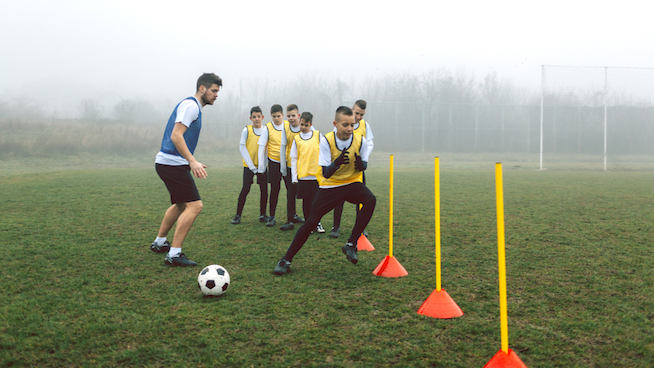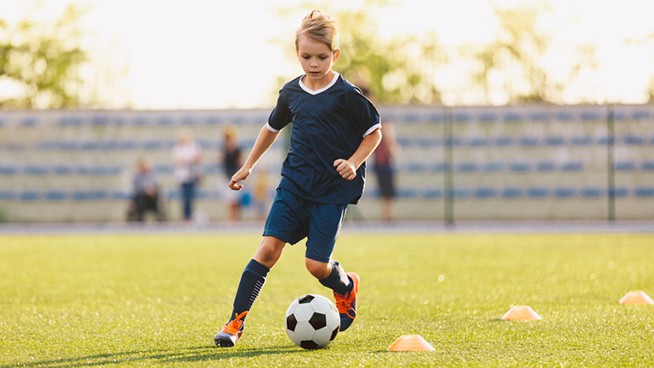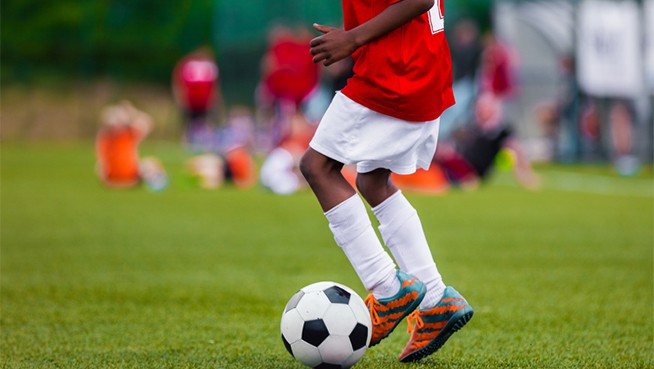How to Build Real Soccer Agility
The most common question I get from soccer parents and coaches is how to improve agility on the pitch.
After all, soccer is a game of multi-directional runs, quick turns against pressure, and lightning-fast scrambles to recover position. Having the agility to change directions just a hair faster than your opponent is sometimes the difference between winning and losing.
Where most players go wrong when training agility is doing drills without a purpose. Coaches toss out cones in a zig-zag fashion or lay out a speed ladder, tell their players to run through at top speed and focus on making sharp cuts, and that’s that.
But building real soccer agility requires more than these tedious drills. Building agility requires a multifaceted approach that focuses on several factors; namely proper stance, mobility, stability, strength, power, intensity and reactivity. These components build off one another, and if a player is able to hone in on all of them, they’re well on their way to maneuvering the pitch with elite agility.
With that in mind, here are five things to focus on for building real soccer agility.
1. Learn the Athletic Stance
I’m willing to bet not too many young soccer players have been taught what it feels like to be in a proper athletic stance. I’d argue this is one of the first things that should be taught before we have them jump blindly into an agility drill.
Why is the athletic stance so critical?
A proper athletic stance sees the player lower their center of gravity and stand with a wide enough base of support that they’re able to move in any direction efficiently. It also teaches players to load the hamstrings and glutes, which are primary muscles used to change directions in a powerful, explosive manner. Once a player gets comfortable in an athletic stance and the position becomes second nature, they’re able to safely and efficiently change directions and perform a move/fake against a defender.
The next progression from athletic stance would be learning which leg to load when cutting and changing direction. Here’s a simple way to introduce this essential concept to your players:
2. Improve Mobility and Stability
Mobility allows for free movement of the limbs, and stability ensures athletes are able to control their balance and exert force efficiently when changing directions. Mobility without stability isn’t nearly as valuable as the two being present together, and vice versa.
The main parts of the body I’m looking at in terms of mobility are the hips (flexion), ankles (dorsiflexion), and trunk (stability). Together, quality mobility in these areas help a player maintain good posture and balance during movement.
Lateral mobility and stablity drills, such as those shown above, are a great warm-up for an agility training session. They not only get athletes moving in the frontal plane, but they also mobilize and stabilize certain muscle groups.
3. Build Strength and Power
This is where the weight room comes into play. Sure, pitch training will improve our players’ technical and tactical skills, but weight room training is the key ingredient for building strength and power in all planes of motion.
Lateral strength and power helps players put more force into the ground when changing directions, resulting in better agility. Lateral lunge variations, Bounding and rotational power exercises are excellent ways to help athletes get comfortable moving in multiple planes. Beginners will get the most benefit from these movements by starting with just their body weight and slowly adding weight over time.
4. Train at Maximum Intensity
To prepare for the multi-directional demands of the game, players must be training agility at game-like intensity. These high-intensity training sessions are best done when players are on a hiatus from competitive games and tournaments.
During the players’ offseason, I’d recommend at least one or two full speed agility sessions per week. Since change of direction is overloaded during the preseason and regular season via small-sided and full field games, players should not focus on performing it at high intensities during training during these times. The offseason is the prime season for coaches or strength coaches to not only teach change of direction skills, but to also drill them at maximum intensity.
With that said, proper rest intervals need to be utilized for these agility drill reps to be most beneficial. We want every rep to be performed at high speed. If we keep the rest intervals short, the players will simply be too winded to execute each rep as desired. Then we essentially turn our agility session into a conditioning session. I recommend a rest interval of 90-120 seconds between each rep for most agility drills.
But simply telling a player you want them to perform a drill at top speed doesn’t guarantee they’ll actually do it. Know what does? Making every drill a competition or race. I’ve found players step things up a notch when they’re racing an opponent to the finish line, or when you have one player chasing the other through the drill. Not only does this help them train at game-like speeds, but kids have more when they compete. It’s a win-win. Integrating races or tag-style games during your agility sessions can be a great idea.
5. Train Reactive Agility
Before I dive into the final and arguably most critical component of agility training, let me ask you a question: Are your players fast movers, fast thinkers or both?
Because if they’re one but not the other, their agility is going to seriously suffer. This is why training what’s known as reactive agility is so important. While structured or “planned” agility drills (which are essentially any drill where the player knowns what moves or cuts they’ll be executing before they start the rep) are excellent for training things like the proper athletic stance and good form on cutting and changing directions, players eventually must process to drills that test their reaction time and decision-making skills.
Reactive agility drills are exactly what they sound like. They require the player to react to an external stimuli during the drill, as opposed to knowing exactly what they’ll be doing before they start the reps. This trains their ability to process that stimuli and react accordingly as fast as possible, which much more closely mimics the rigors of a game than a planned drill.
The above drill (video quality may need to be set at 720p or lower to run smoothly) is an example of a reactive agility drill that also incorporates competitive elements. The player facing the coach is reacting to the direction of where the coach points their finger. The player facing away from the coach is reacting to the other player’s movements. Neither one of them have any idea where they’ll be moving next—they must rely on their eyes and their reaction skills to respond to the chaos. There are an endless number of other reactive agility drills that can be incorporated into soccer players’ training routines, as the only limit is really their coach’s imagination. The more the drill can simulate what they’ll face in a real game, the better. A ball can even be added to the player’s feet during a drill for another level of progression.
Although this list may seem extensive, building excellent agility requires a multi-faceted approach. Attacking all of these layers is needed to develop the complete player who can swirl around the pitch with speed and precision.
Photo Credit: vgajic/iStock
RECOMMENDED FOR YOU
MOST POPULAR
How to Build Real Soccer Agility
The most common question I get from soccer parents and coaches is how to improve agility on the pitch.
After all, soccer is a game of multi-directional runs, quick turns against pressure, and lightning-fast scrambles to recover position. Having the agility to change directions just a hair faster than your opponent is sometimes the difference between winning and losing.
Where most players go wrong when training agility is doing drills without a purpose. Coaches toss out cones in a zig-zag fashion or lay out a speed ladder, tell their players to run through at top speed and focus on making sharp cuts, and that’s that.
But building real soccer agility requires more than these tedious drills. Building agility requires a multifaceted approach that focuses on several factors; namely proper stance, mobility, stability, strength, power, intensity and reactivity. These components build off one another, and if a player is able to hone in on all of them, they’re well on their way to maneuvering the pitch with elite agility.
With that in mind, here are five things to focus on for building real soccer agility.
1. Learn the Athletic Stance
I’m willing to bet not too many young soccer players have been taught what it feels like to be in a proper athletic stance. I’d argue this is one of the first things that should be taught before we have them jump blindly into an agility drill.
Why is the athletic stance so critical?
A proper athletic stance sees the player lower their center of gravity and stand with a wide enough base of support that they’re able to move in any direction efficiently. It also teaches players to load the hamstrings and glutes, which are primary muscles used to change directions in a powerful, explosive manner. Once a player gets comfortable in an athletic stance and the position becomes second nature, they’re able to safely and efficiently change directions and perform a move/fake against a defender.
The next progression from athletic stance would be learning which leg to load when cutting and changing direction. Here’s a simple way to introduce this essential concept to your players:
2. Improve Mobility and Stability
Mobility allows for free movement of the limbs, and stability ensures athletes are able to control their balance and exert force efficiently when changing directions. Mobility without stability isn’t nearly as valuable as the two being present together, and vice versa.
The main parts of the body I’m looking at in terms of mobility are the hips (flexion), ankles (dorsiflexion), and trunk (stability). Together, quality mobility in these areas help a player maintain good posture and balance during movement.
Lateral mobility and stablity drills, such as those shown above, are a great warm-up for an agility training session. They not only get athletes moving in the frontal plane, but they also mobilize and stabilize certain muscle groups.
3. Build Strength and Power
This is where the weight room comes into play. Sure, pitch training will improve our players’ technical and tactical skills, but weight room training is the key ingredient for building strength and power in all planes of motion.
Lateral strength and power helps players put more force into the ground when changing directions, resulting in better agility. Lateral lunge variations, Bounding and rotational power exercises are excellent ways to help athletes get comfortable moving in multiple planes. Beginners will get the most benefit from these movements by starting with just their body weight and slowly adding weight over time.
4. Train at Maximum Intensity
To prepare for the multi-directional demands of the game, players must be training agility at game-like intensity. These high-intensity training sessions are best done when players are on a hiatus from competitive games and tournaments.
During the players’ offseason, I’d recommend at least one or two full speed agility sessions per week. Since change of direction is overloaded during the preseason and regular season via small-sided and full field games, players should not focus on performing it at high intensities during training during these times. The offseason is the prime season for coaches or strength coaches to not only teach change of direction skills, but to also drill them at maximum intensity.
With that said, proper rest intervals need to be utilized for these agility drill reps to be most beneficial. We want every rep to be performed at high speed. If we keep the rest intervals short, the players will simply be too winded to execute each rep as desired. Then we essentially turn our agility session into a conditioning session. I recommend a rest interval of 90-120 seconds between each rep for most agility drills.
But simply telling a player you want them to perform a drill at top speed doesn’t guarantee they’ll actually do it. Know what does? Making every drill a competition or race. I’ve found players step things up a notch when they’re racing an opponent to the finish line, or when you have one player chasing the other through the drill. Not only does this help them train at game-like speeds, but kids have more when they compete. It’s a win-win. Integrating races or tag-style games during your agility sessions can be a great idea.
5. Train Reactive Agility
Before I dive into the final and arguably most critical component of agility training, let me ask you a question: Are your players fast movers, fast thinkers or both?
Because if they’re one but not the other, their agility is going to seriously suffer. This is why training what’s known as reactive agility is so important. While structured or “planned” agility drills (which are essentially any drill where the player knowns what moves or cuts they’ll be executing before they start the rep) are excellent for training things like the proper athletic stance and good form on cutting and changing directions, players eventually must process to drills that test their reaction time and decision-making skills.
Reactive agility drills are exactly what they sound like. They require the player to react to an external stimuli during the drill, as opposed to knowing exactly what they’ll be doing before they start the reps. This trains their ability to process that stimuli and react accordingly as fast as possible, which much more closely mimics the rigors of a game than a planned drill.
The above drill (video quality may need to be set at 720p or lower to run smoothly) is an example of a reactive agility drill that also incorporates competitive elements. The player facing the coach is reacting to the direction of where the coach points their finger. The player facing away from the coach is reacting to the other player’s movements. Neither one of them have any idea where they’ll be moving next—they must rely on their eyes and their reaction skills to respond to the chaos. There are an endless number of other reactive agility drills that can be incorporated into soccer players’ training routines, as the only limit is really their coach’s imagination. The more the drill can simulate what they’ll face in a real game, the better. A ball can even be added to the player’s feet during a drill for another level of progression.
Although this list may seem extensive, building excellent agility requires a multi-faceted approach. Attacking all of these layers is needed to develop the complete player who can swirl around the pitch with speed and precision.
Photo Credit: vgajic/iStock











